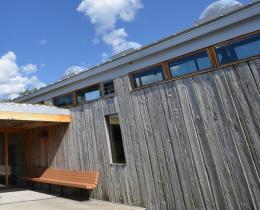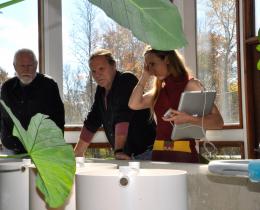ARTICLE

Truth to Power: A Young Climate Activist’s Journey
For Birch Kinsey, 18, social justice is a central issue of the climate change movement—even if it means holding some legendary leaders accountable.
Birch Kinsey speaks at the 2019 Drawdown Learn Conference.
On a dreary, moonless evening at the edge of the Catskills, Birch Kinsey wasn't expecting to confront a legend of the climate change movement.
It was the opening night of the Youth Empowerment & Sustainability Summit (YESS) at the Ashokan Center, and the keynote speaker was Dr. James Hansen. Hansen is the former director of the NASA Goddard Institute for Space Studies and now serves as the director of the Climate Science, Awareness, and Solutions program at Columbia University’s Earth Institute. He is perhaps best known for highlighting the link between greenhouse gas emissions and climate change in testimony before Congress in the 1980s.
"He is a reverberating force in the climate change movement," said Tim Guinee, chair of the Hudson Valley Climate Reality Project, as he introduced Hansen to an audience made up mostly of school children from around the New York, as well as some from England and Sweden.
But by the time his talk was completed, something else was reverberating around the Ashokan Center’s performance hall: the comments of an 18-year-old African-American climate justice activist from Buffalo.
When Hansen said, "Yeah, I’m all in favor of social justice, but don’t do it in a way that kills the climate solution," Kinsey could not contain herself.
"Why don’t the low-income people get to decide that for themselves?" asked Kinsey, who served on youth panels at Omega’s 2018 and 2019 Drawdown Learn conferences.
The Rise of Climate Justice Activism
The moment was emblematic of the tension that exists between more measured approaches to climate policy and the strident urgency that underpins climate justice activism.
Climate justice is the lens through which climate solutions are viewed from a human rights perspective. The concept stems from the fact that poor and otherwise marginalized communities—and nations—suffer the impacts of pollution and climate change far more acutely than wealthier communities do. Correcting that inequity is one of the pillars of the youth climate movement. Kinsey’s question was another poignant example of the truth-to-power fearlessness that has made the youth movement so compelling.
"I was definitely a small ball of anger," Kinsey said. "I didn’t see anybody else who looked upset or perturbed. And I was scared that the 12-year-olds (in the audience) might accept that as their framework moving forward."
Finding Strength in Climate Solutions—For Herself & Others
"She doesn’t shy away from difficult conversations," said Erin Griffin, a climate and communities coordinator at the Wild Center and one of Kinsey’s mentors.
It wasn’t always that way. Kinsey said she has had struggles with depression and anxiety. But she said that working on climate change and climate justice from a solutions-based perspective has provided her with growing confidence, resolve, and sense of purpose. She has facilitated workshops for youth, educators, and other professionals, including a climate justice workshop at YESS.
"She has a skill in bringing climate justice to the forefront and getting people to talk about those issues in a way that feels pretty approachable and not intimidating," Griffin said. "She creates an environment where those conversations can happen. That is an incredible skill for a young person to have. And it’s so important."
Kinsey credits her growth, in part, to Project Drawdown, the organization behind the 2017 best-seller Drawdown: The Most Comprehensive Plan Ever Proposed to Reverse Global Warming, and to Omega’s Drawdown Learn conferences.
"I know for a fact that without Drawdown, I would be in full despair mode," Kinsey said. "I never had panic attacks until I started doing climate work. I still have them. But I know, now, there is a way forward. I don’t think anything magical happened at Drawdown Learn conferences other than me walking out knowing that we have a solution. And no one can tell me otherwise."
Another influence has been the work of Leah Penniman, codirector and farm manager at Soul Fire Farm. Soul Fire Farm is a community farm in upstate New York led by and for black, indigenous, and people of color that seeks to ending racism and injustice in the food system. In 2017, Soul Fire Farm received Omega’s Leadership in Sustainable Education Award and Penniman has served on the faculty of workshops and conferences at Omega.
Penniman is the author of Farming While Black: Soul Fire Farm's Practical Guide to Liberation on the Land. The book, in part, details the significant and often overlooked contributions that black people have made to American farming practices.
"That," Kinsey said of the book’s impact, "was a whole paradigm shift."
Indeed, Kinsey has her own dreams of farming. Her family owns a piece of land in Broome County, New York, that she plans to cultivate. And in the fall, she will attend Warren Wilson College, a small liberal arts institution in North Carolina that has its own working farm.
"Part of being a black woman is this pain that comes from knowing your culture was stolen from you and not feeling you have anything to connect you to that," Kinsey said. "But farming and working to build a regenerative relationship with the planet makes me feel as if I am connecting to that legacy."


